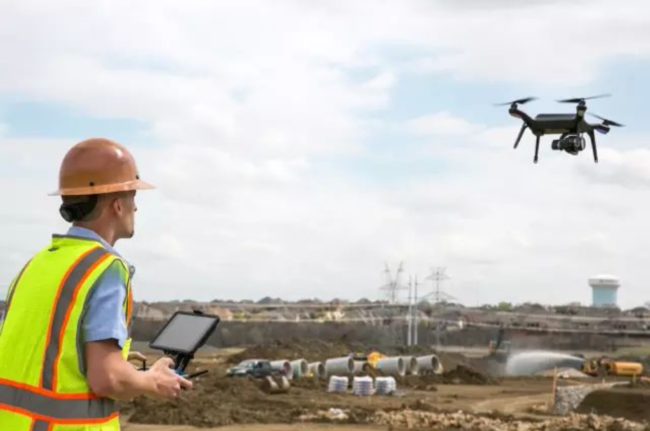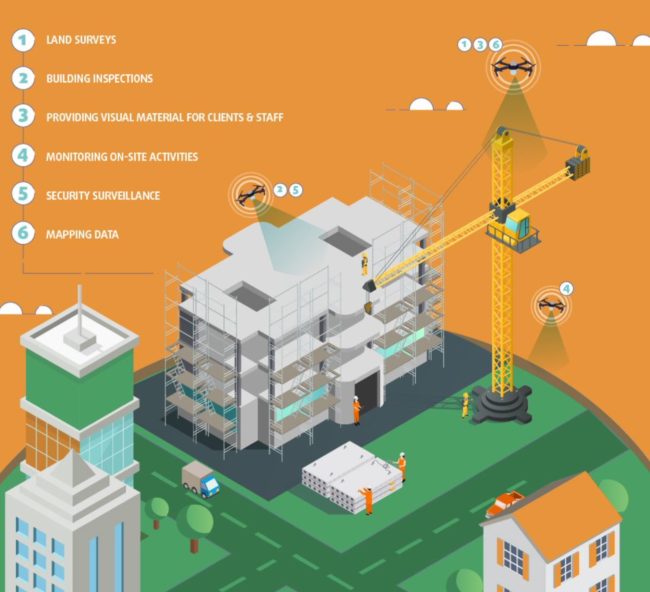
Building Tomorrow: Drones in Construction
Aerial imaging allows for contractors to see entire sites in a fraction of the time it takes humans to survey them.
Drones are making waves across multiple industries by making company operations more efficient and finding creative solutions to years old problems. One of these industries is the construction sector, where they have enabled builders to drastically cut project times and keep workers safer than ever before.
Drones can benefit builders even before work is scheduled to begin. Surveys of potential construction sites can highlight any possible complications with elevation or the foundation of the site, indicating that the project may benefit from building elsewhere. It can also help architects in planning the project, by simulating how the completed building may affect the surrounding areas. Before, data on work sites was collected manually, through in-person walkthroughs by contractors on site. This process takes up considerable resources and man hours, as the builders have to walk the perimeter of the site themselves, which can be time consuming depending on the size of the project. Additionally, manual data collection often results in data that is less accurate than if it was collected via drone survey.

Drone being deployed in to survey & map a construction site.
Drones allow contractors to monitor and collect data on the progress of their projects in real time. This is invaluable in helping builders and planners to accurately assess the development and efficiency of their work site, and allows them to catch any possible complications as they happen. This data can also highlight potential bottlenecks or work stoppages in different areas of the site, which allows companies to target those areas and fix the problems and keeps managers accountable. The aerial data drones provide also gives workers access to a wide array of tools and mapping data, such as detailed GPS maps that make the data accessible and keep it up to date. These maps can also help to keep track of available materials on site, which minimizes delays and accompanying monetary losses.
The visual data that drones are able to collect also benefits their clients and shareholders, as they can receive precise and frequent updates about the progress of their projects. This helps to keep everyone involved in a project on the same page in terms of the work that is completed and what is left to be done. If delays or complications occur on the work site, drones can highlight them for supervisors, ensuring that they are handled quickly and before they cost significantly more money to fix. When dealing with large scale projects, this is invaluable, and can save shareholders millions of dollars.

Drones can provide versatile solutions and excel in a variety of roles around the job site.
While drones can greatly increase a work site’s productivity and efficiency, they also excel at keeping workers safe. Some sites have areas that would prove to be too hazardous for workers to inspect manually, such as compromised infrastructure or extreme heights. Sending a drone to collect data instead can keep workers from being put in unnecessary danger, while benefiting the foreman with data that is more accurate and efficient than what humans would have been able to collect anyway. Drones can also be utilized to conduct safety inspections of the site, checking for any weaknesses or structural concerns during the project timeline and keeping workers safe.
Drone technology can greatly increase the speed and reduce the costs of construction projects, passing along the benefits to the clients. For example, according to Identified Technologies, the lead time for surveying a 100-acre work site with a manned survey team can take around seven weeks. Meanwhile, a drone can collect the data in nine minutes, and process its findings within six hours, saving both time and resources. Looking to the future, as technology improves work sites will only become more efficient and streamlined, helping to reduce the project times across the board. Advancements could also allow drones to take a more hands-on role in construction, even doing some of the building themselves. This more involved form of construction is only currently limited by FAA drone laws regulating how drones are allowed to operate around buildings and within cities, but the capabilities of the technology itself is rapidly approaching this reality. Currently, the use of drones by construction firms presents a considerable competitive advantage when pursuing contracts, but that advantage won’t last long as more and more contractors are finding ways to use drones to elevate their proposals.